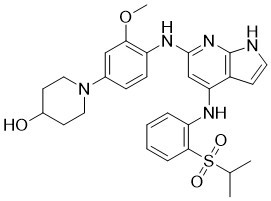Mps1-IN-1 is a novel, ATP-competitive, selective and potent Mps1 kinase inhibitor with antitumor activity. Its IC50 and Kd are 367 nM and 27 nM, respectively, indicating that it inhibits Mps1 kinase.
Physicochemical Properties
| Molecular Formula | C28H33N5O4S |
| Molecular Weight | 535.65772 |
| Exact Mass | 535.225 |
| Elemental Analysis | C, 62.78; H, 6.21; N, 13.07; O, 11.95; S, 5.99 |
| CAS # | 1125593-20-5 |
| Related CAS # | 1125593-20-5 |
| PubChem CID | 25195352 |
| Appearance | Light yellow to yellow solid powder |
| LogP | 5.842 |
| Hydrogen Bond Donor Count | 4 |
| Hydrogen Bond Acceptor Count | 8 |
| Rotatable Bond Count | 8 |
| Heavy Atom Count | 38 |
| Complexity | 862 |
| Defined Atom Stereocenter Count | 0 |
| SMILES | O=S(C(C=CC=C1)=C1NC2=CC(NC3=C(OC)C=C(N4CCC(O)CC4)C=C3)=NC5=C2C=CN5)(C(C)C)=O |
| InChi Key | NMJMRSQTDLRCRQ-UHFFFAOYSA-N |
| InChi Code | InChI=1S/C28H33N5O4S/c1-18(2)38(35,36)26-7-5-4-6-23(26)30-24-17-27(32-28-21(24)10-13-29-28)31-22-9-8-19(16-25(22)37-3)33-14-11-20(34)12-15-33/h4-10,13,16-18,20,34H,11-12,14-15H2,1-3H3,(H3,29,30,31,32) |
| Chemical Name | -[3-methoxy-4-[[4-(2-propan-2-ylsulfonylanilino)-1H-pyrrolo[2,3-b]pyridin-6-yl]amino]phenyl]piperidin-4-ol |
| Synonyms | Mps1 IN 1; Mps1-IN-1; Mps1-IN 1; Mps1 IN-1 |
| HS Tariff Code | 2934.99.9001 |
| Storage |
Powder-20°C 3 years 4°C 2 years In solvent -80°C 6 months -20°C 1 month |
| Shipping Condition | Room temperature (This product is stable at ambient temperature for a few days during ordinary shipping and time spent in Customs) |
Biological Activity
| Targets | Mps1 (IC50 = 367 nM); Mps1 (Kd = 27 nM); ALK (Kd = 21 nM); LTK (Kd = 29 nM); PYK2 (Kd = 280 nM); FAK (Kd = 440 nM); IGF1R (Kd = 750 nM); INSR (Kd = 470 nM); CLK1 (Kd = 1900 nM); ERK2 (Kd = 2900 nM); INSRR (Kd = 1200 nM); TNK1 (Kd = 2600 nM); TNK2 (Kd = 3100 nM); GAK (Kd = 1100 nM) |
| ln Vitro | Mps1-IN-1 has IC50 and Kd values of 367 and 27 nM, respectively. It is a strong, selective, and ATP-competitive Mps1 substitute. With Kd values of 21 and 39 nM, respectively, Mps1-IN-1 likewise has significant affinity for ALK and LTK, but its inhibitory effect on the 352 halted members is negligible. In U2OS cells, Mps1-IN-1 (5,10 μM) causes mitotic branching controlled by route checkpoints. 1 lowers the phosphorylation state of Aurora B at threonine 232 (Thr232) and interferes with Mad2's recruitment to centromeres. There is no impact of Mps1-IN-1 (10 μM) on centrosome duplication. Furthermore, Mps1-IN-1 (5–10 μM) prevents HCT116 from proliferating [1]. |
| Enzyme Assay | The ATP site-directed kinase inhibitor Kinase Tracer 236 is fluorescently labeled, and its displacement from the kinase active site is monitored in the kinase binding assay to evaluate compound binding to TTK. 5 nM TTK, varying concentrations of test compound (Mps1-IN-1), 30 nM Kinase Tracer 236; 2 nM Eu-anti-GST Antibody; and 1% DMSO (remaining after compound dilution) are all included in each 15 μL assay. Kinase Buffer A comprises 50 mM HEPES pH 7.5, 10 mM MgCl2, 1 mM EGTA, and 0.01% Brij-35. In binding assays, 5 μL of a kinase/antibody mixture and 5 μL of the test compound (from the 2-fold dilution series) are added first, and then 5 μL of the antibody. Standard Eu-based TR-FRET settings are used to read assay plates, with excitation occurring at 340 nm and emission being observed at 615 nm (donor) and 665 nm (acceptor). A 100 µs post-excitation delay is followed by a 200 µs window for measuring emission intensities[1]. |
| Cell Assay | In 96-well plates, U2OS cells expressing PLK4 that is induced by doxycycline are plated. The protocol for a double thymidine block is as follows: thymidine for 18–20 hours, release for 10 hours (doxycycline induction of PLK4 during this time), and then another thymidine block and release. Mps1-IN-1 (or DMSO vehicle) is added six hours after the second thymidine release, and the Cell Titer GLO assay is used to track the proliferation of the cell populations[1]. |
| References |
[1]. Small-molecule kinase inhibitors provide insight into Mps1 cell cycle function. Nat Chem Biol. 2010 May;6(5):359-68. |
| Additional Infomation | 1-[3-methoxy-4-[[4-(2-propan-2-ylsulfonylanilino)-1H-pyrrolo[2,3-b]pyridin-6-yl]amino]phenyl]-4-piperidinol is a member of piperidines. |
Solubility Data
| Solubility (In Vitro) | DMSO: ≥ 39 mg/mL (~72.8 mM) |
| Solubility (In Vivo) |
Solubility in Formulation 1: ≥ 2.5 mg/mL (4.67 mM) (saturation unknown) in 10% DMSO + 40% PEG300 +5% Tween-80 + 45% Saline (add these co-solvents sequentially from left to right, and one by one), clear solution. For example, if 1 mL of working solution is to be prepared, you can add 100 μL of 25.0 mg/mL clear DMSO stock solution to 400 μL PEG300 and mix evenly; then add 50 μL Tween-80 + to the above solution and mix evenly; then add 450 μL normal saline to adjust the volume to 1 mL. Preparation of saline: Dissolve 0.9 g of sodium chloride in 100 mL ddH₂ O to obtain a clear solution. (Please use freshly prepared in vivo formulations for optimal results.) |
| Preparing Stock Solutions | 1 mg | 5 mg | 10 mg | |
| 1 mM | 1.8669 mL | 9.3343 mL | 18.6686 mL | |
| 5 mM | 0.3734 mL | 1.8669 mL | 3.7337 mL | |
| 10 mM | 0.1867 mL | 0.9334 mL | 1.8669 mL |
